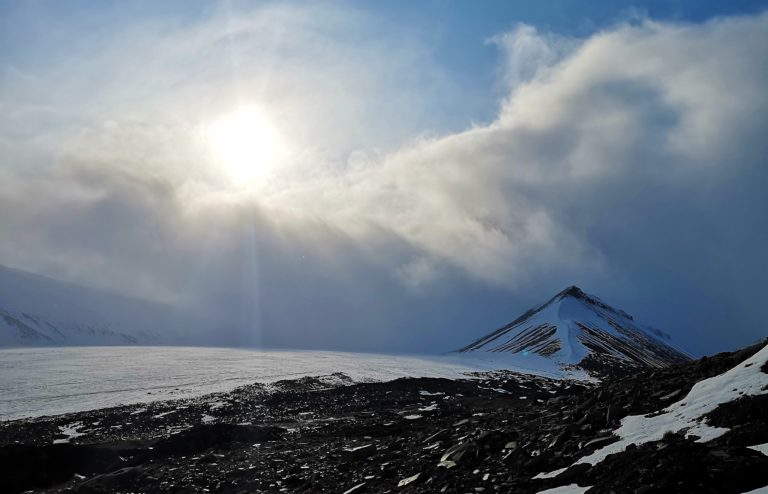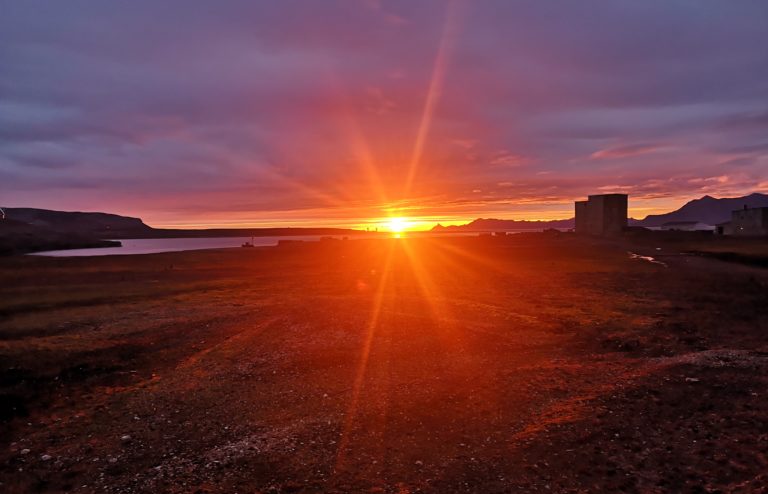Teamwork and Fieldwork: Environmental Studies in the Arctic Part 2
Student experience 15 April 2020
Join PhD student Emma Burns on her second trip to the Arctic for the British Antarctic Survey short course covering ‘safe and effective fieldwork in the polar regions’.
Polar fieldwork requires vast amounts of planning and organisation, something early career researchers do not always have time to appreciate during their short studies. I was lucky enough to be one of ten PhD students to attend the British Antarctic Survey advanced training short course: safe and effective fieldwork in the polar regions, in the summer of 2019. The course consisted of two parts, a theory-based set of lectures and workshops in the UK and a practical application of our skills in the high Arctic of Svalbard.

Ny-Ålesund Research Station
Our initial training began at the UK headquarters of The British Antarctic Survey in Cambridge, which is where all activities and logistics are planned for both the Arctic and Antarctic. Our theory training involved learning to develop a field plan including the legislative obligations, risk assessments and environmental impact of polar field activities. We also had practical sessions to acquire skills such as mapping using GPS and GIS technology and polar leadership qualities.

British Antarctic Survey headquarters based in Cambridge, UK
Once our theory based learning was complete it was time to apply our new skills in the polar environment. This involved travelling to the Norwegian archipelago of Svalbard in the Arctic Ocean, East of Greenland and North of Norway. We began with team bonding and building, which we quickly realised was one of the key aspects of successful but, more importantly, safe polar fieldwork. We climbed to the top of the local peak of Trollsteinen which involved crossing two glaciers; Longyearbreen and Larsbreen and eventually traversing a ridge up to the summit. During this hike every team member had to be vigilant due to Svalbard being home to over 3000 polar bears, greater than the total human population.

View of Trollsteinen from the Larsbreen glacier
A key aspect of Arctic life, which is evident almost instantly when you arrive, are huskies. They are versatile animals, they are used for transport, protection and companionship. They also form perfect teams when they are put together as a sled group, we learnt about how their dynamics are formed and the bond the dogs form with each other and their master.

Huskies forming the back pair of the sled pack, these are the strongest dogs in the group
The final part of our trip involved travelling via a small prop plane to the research station located in Ny-Ålesund, considered the Earth’s most northerly settlement. It is home to an international research community (including the UKs Arctic station) with activities being carried out year round in the fields of marine, atmospheric, terrestrial ecology and glaciology. Before we could get out into the field we had some safety training to do, specifically polar bear rifle safety. This is key, as they regularly have bears crossing through the station to get to the waters of the Fram Strait where their prey is located. During our time on station we engaged in lots of different science activities which allowed us to apply our theoretical training such as glacial surveys, marine and terrestrial ecology analysis and palaeontology. We also made field plans for each day and learnt how to adapt these depending on variables such as weather and bear sightings.

View of research station from plane coming in to land, below are the waters of Kongfjorden.
I hope to apply some of the key skills taught on this course for future fieldwork and hopefully in a career as a polar scientist. My biggest take home was that although there were representatives from many different nations occupying the research station, they worked as one team demonstrating how teamwork is a powerful tool in the polar regions and invaluable for safe and effective fieldwork.

The sun beginning to set over the fjord as the end of 24 hour daylight period begins
To conclude the post, I asked Emma how she was finding working from home in the current circumstances.
“With regards to working at home I would say the main thing is sticking to a routine and managing your expectations of yourself and what is achievable. These are strange times and its okay to not be one hundred percent productive all of the time”.
You can follow Emma on Twitter @ArcticBurns
ArcticBritish Antarctic SurveyfieldworkGISglacial surveysGPSmappingmarine ecologypalaeontologypolar scientistSvalbardteamworkterrestrial ecologyTrollsteinen




Leave a Reply